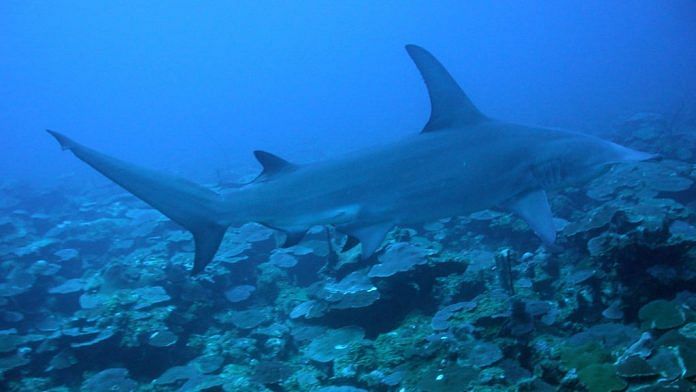New Delhi: The seas are awash with plastic waste more than ever and choking marine life at an unprecedented pace. A recent study found reports of as many as 1,116 sharks and rays entangled in plastic items in the oceans – including the Atlantic, Pacific and the Indian. Among other things, discarded fishing nets, ropes and gears are mostly to be blamed for the ghastly deformities seen among the marine beings and also their death.
This study throws light on the dangers of human-made litter underwater and the challenges before de-polluting the oceans. The United Nations has this year launched a global campaign against plastic pollution in the oceans, and said the menace has led to a “global environmental catastrophe”.
Researchers from the University of Exeter in the UK who scoured existing published works and Twitter for shark and ray entanglements have found reports of more than 1,000 incidents in the study published in Endangered Species Research.
The numbers could be even higher since few researches have focussed on plastic entanglement among sharks and rays, it says.
The team had researched records of scientific literature as far back as 1940, and selected 26 papers documenting incidents from the three affected ocean basins. To complement the published works, they also searched Twitter accounts between 2009 and 2019 – from the first recorded tweet.
Issue ‘under radar’
The study also adds that even though plastic entanglements pose a far lesser threat to sharks and rays than commercial fishing, the deformities these cause to animals are a serious cause for concern.
“One example in the study is a shortfin mako shark with fishing rope wrapped tightly around it. The shark had clearly continued growing after becoming entangled, so the rope – which was covered in barnacles – had dug into its skin and damaged its spine,” said Kristian Parton, from the university, in a statement.
The researchers also said direct threat posed by over-fishing of sharks and rays, and accidental catching while fishing for other species, had put the menace of plastic entanglement “under the radar”.
“We set out to remedy this. Our study was the first to use Twitter to gather such data, and our results from the social media site revealed entanglements of species – and in places – not recorded in academic papers,” said Brendan Godley, one of the authors of the study.
Also read: Unborn sharks that swim in the womb and some ‘vicious’ small cats
Common ‘entangling objects’
The review of academic papers found reports of 557 sharks and rays, spanning 34 species, entangled in plastic in oceans including the Atlantic, Pacific and Indian. Almost 60 per cent of these animals were either lesser spotted dogfish, spotted ratfish or spiny dogfish.
On Twitter, the researchers found 74 entanglement reports involving 559 individual sharks and rays from 26 species including whale sharks, great whites, tiger sharks and basking sharks.
Both data sources suggested fishing gear – such as nets, lines and other lost or abandoned equipment – as the most common ‘entangling objects’. Other items included strapping bands used in packaging, polythene bags and rubber tyres.
The study also identified factors that put certain species more at risk due to their habitats, migration patterns and body shapes.
Sharks and rays living in the open ocean are more likely to get entwined. Similarly, those living near the sea floor – where items such as fishing nets loaded with dead fish usually sink and attract predators – also get entangled in plastic more frequently.
Species that cover long distances are at risk of encountering plastic waste and those with unique physical features – such as manta rays, basking sharks and sawfish – are also at risk.
Also read: Earthworms: A fresh challenge in the fight against global warming



